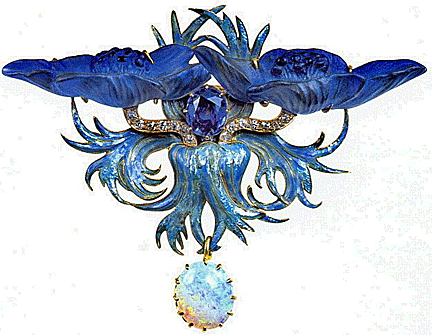 The
Art Nouveau style is perhaps best expressed in the delicate,
imaginative, colorful, and poetic jewelry of the period. While Art
Nouveau embraced all manner of decoration, it’s jewels best express its
style. Their fragility and their infinite variations of size, color and
shape made them ideal example of the new style.
The
Art Nouveau style is perhaps best expressed in the delicate,
imaginative, colorful, and poetic jewelry of the period. While Art
Nouveau embraced all manner of decoration, it’s jewels best express its
style. Their fragility and their infinite variations of size, color and
shape made them ideal example of the new style.
Designers created Art Nouveau jewelry in France between 1895 and 1910.
Though jewelry makers of the time didn’t produce it in quantity, it was
of the finest quality. They were inventive in their designs and expertly
crafted each piece. The two leading jewelry makers of the time, Vever
and Henri Bouuilet, both represented old family firms.
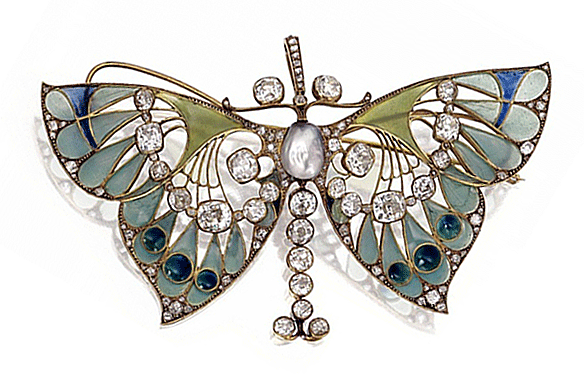
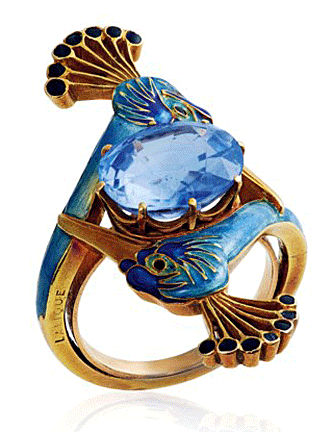 While
jewelry makers in other countries produced pieces similar ones to Art
Nouveau, authentic jewelry in the new style came from France. It was a
short-lived period in jewelry design, lasting only about 15 years,
because of the onset of World War I and because the pieces were so
over-the-top and expensive that people quickly lost interest in them.
While
jewelry makers in other countries produced pieces similar ones to Art
Nouveau, authentic jewelry in the new style came from France. It was a
short-lived period in jewelry design, lasting only about 15 years,
because of the onset of World War I and because the pieces were so
over-the-top and expensive that people quickly lost interest in them.
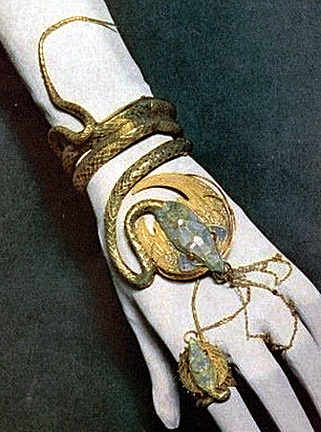 Art
Nouveau jewelry was a reaction to a number of things going on in French
society at that time, including women’s fight to secure more rights for
themselves outside of the home by getting an education and a job.
Art
Nouveau jewelry was a reaction to a number of things going on in French
society at that time, including women’s fight to secure more rights for
themselves outside of the home by getting an education and a job.
The pieces were large and ostentatious, and a lot of them depicted naked
women, a shocking motif at the time. Because Art Nouveau jewelry was
costly, only wealthy, artistic women wore it. Demimonde, unmarried women
who were supported by wealthy lovers and considered to be on the fringes
of acceptable society, wore Art Nouveau jewelry as did a number of
well-known entertainers. The most recognizable was actress Sarah
Bernhardt, who helped to make jewelry designer René Lalique famous.
While most old jewelry ends up getting melted down, Art Nouveau pieces
wouldn’t have been worth while as they usually had very little value.
They may have been so disliked when fashion changed that people simply
destroyed or mislaid them.
Materials Used
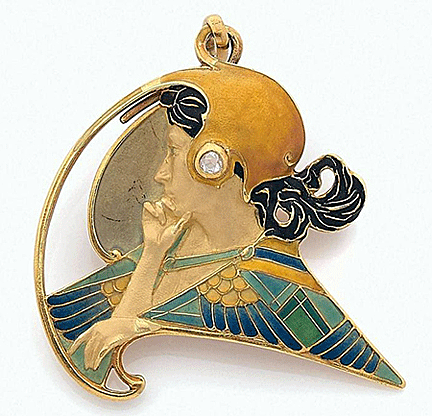 With
Art Nouveau jewelry, the materials weren’t as important as the design.
The pieces were less about gemstones and more about enamel, including
plique-à-jour enamel. French for “letting in daylight,” plique-à-jour
enamel was translucent, much like a stained-glass window.
With
Art Nouveau jewelry, the materials weren’t as important as the design.
The pieces were less about gemstones and more about enamel, including
plique-à-jour enamel. French for “letting in daylight,” plique-à-jour
enamel was translucent, much like a stained-glass window.
Jewelry makers heated and bent horn, usually from domestic animals such
as cows, into different shapes for Art Nouveau pieces. They also used a
lot of carved ivory. They added diamonds as accent stones.
Most French artists defied the French hallmark laws and omitted to have
their jewels marked, frightened perhaps of the risk of damage in the
scraping and punching process. Some artists didn’t sign their names. In
most cases a pair of initials seemed adequate.
Leading Art Nouveau Jewelers
In all there were probably three or four dozen artist-jewelers working
in the Art Nouveau style in France. Rene Lalique operated one of the
largest workshops, employing 30 craftsmen at the turn of the 20th
century.
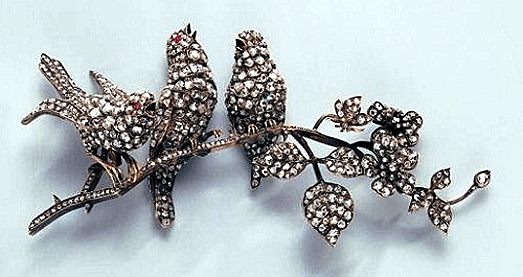
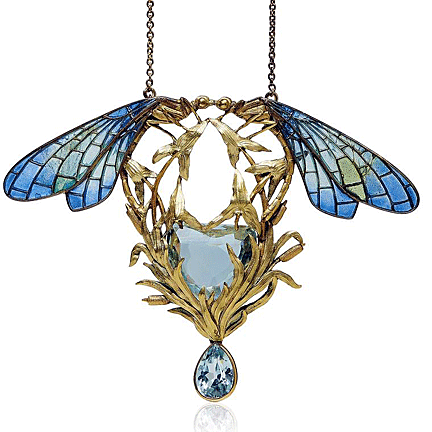 Lalique
was indeed the genius of the Movement. He worked as a freelance designer
and craftsman for quite a few jewelry houses, including Jacta, Aucoc,
Cartier, Boucheron, Renn, Gariod, Hamelin and, most important, Destape,
whose business he finally inherited in 1886.
Lalique
was indeed the genius of the Movement. He worked as a freelance designer
and craftsman for quite a few jewelry houses, including Jacta, Aucoc,
Cartier, Boucheron, Renn, Gariod, Hamelin and, most important, Destape,
whose business he finally inherited in 1886.
Along the way, actress Sarah Bernhardt noticed his work and commissioned
two groups of jewels for Iseyl et Gismonda. In 1895, Lalique won third
prize on his first appearance at the Salon, the same year as his first
recorded use of the female nude in jewelry. In 1896 he first used
horn—an important innovation. In 1897 he became a Chevalier of the
Legion d'Honneur.
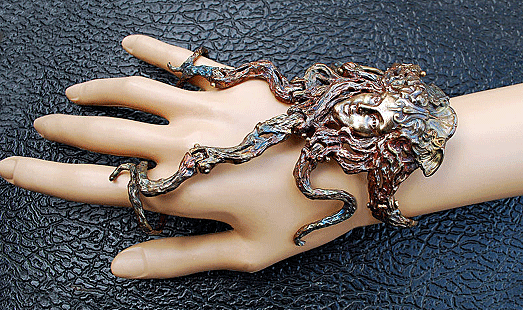
Lalique was a technical, as well as a stylistic, innovator. He used
machinery to reduce his large prototypes to actual working size, and he
employed Eugene Feuillatre to investigate enameling techniques on
silver. He also used platinum, not because of its value, but because he
liked the color. He also made frequent use of glass, horn and
occasionally aluminum. His pieces, more than any other jeweler's, show
the artist's impatience with the mystique of the precious stone.
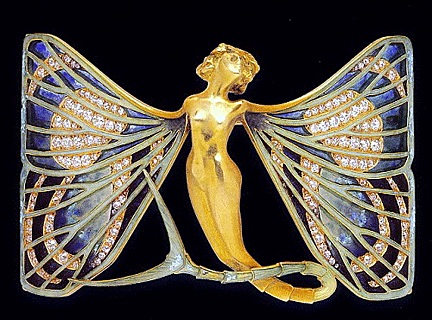
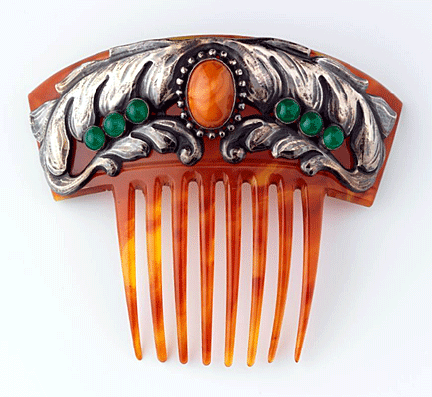 While
Lalique’s style tended to be soft and feminine, that of Georges Fouquet,
the other inspired French Art Nouveau jeweler, was somewhat harsh,
preferring thistles and nightmare insects. He won prizes at the
Exhibitions of 1900 and 1901 and built a new shop at 6, Rue Royale.
While
Lalique’s style tended to be soft and feminine, that of Georges Fouquet,
the other inspired French Art Nouveau jeweler, was somewhat harsh,
preferring thistles and nightmare insects. He won prizes at the
Exhibitions of 1900 and 1901 and built a new shop at 6, Rue Royale.
Henri Vever was another jeweler of standing; and with his brother, Paul,
inherited his father’s firm in 1874. He attended evening classes at the
Ecole des Arts Decoratifs and worked by day with various jewelers —
Loguet, Hallet and Dufong. In 1889 the brothers won two prizes at their
first exhibition and in 1891 the Croix de la Legion d'Honneur at the
French Exhibition in Moscow.
The Art Nouveau movement was played out by 1910, and many of the
jeweler/ craftsmen and patrons died during World War I. Today, these
jewels live on as art and inspiration.
< Back to Collecting Archives
Next Article >
